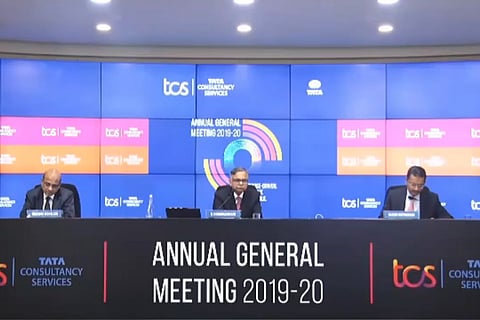

Tata Consultancy Services held its first virtual and 25th Annual General Meeting (AGM) on Thursday, with over 1,200 people in attendance, estimated to be about as many people who attend the meeting in Mumbai every year. The company’s top brass including Tata Sons Chairman N Chandrasekaran and CEO Rajesh Gopinathan who joined in from TCS House, COO NG Subramaniam, Don Callahan and Keki Mistry were among those present.
They said that they were adopting digital channels, which were once only nice to have, and weren’t mandatory. “This is the transformation that we had spoken of five years ago, when we said that ‘Default is Digital’. The sharp shift in consumer preferences has now forced enterprises to significantly accelerate their digital transformation initiatives,” N Chandrasekaran said.
The company said 90% of its 4.5 lakh strong workforce were moved to working from home in a short time, using their Secure Borderless Workplaces operating model. Earlier, COO NG Subramaniam had said that 75% of their employees would be working from home by 2025, and that they do not need more than 25% of their employees at their facilities to be fully productive. They termed this the 25/25 model.
When asked queries about the same, Chandrasekharan called it a “guesstimate”.
“When we say 25% by 2025, it is not a target. We anticipate and predict that the world will move in this direction, and we want to be prepared for it. It is not (may not be) the same 25% of employees as well. It’s just a guesstimate, and could be 40-70%,” he said.
When the company was queried if the same was a cost-saving measure, it said that the shift to working from home added to their expenses.
“In fact, TCS has long-term leases. So, currently it is more investments and more expenses,” he said. The subsequent revenue loss was also absorbed in the March quarter, Chandrasekharan added.
He added that the work from home arrangement was not being viewed as a temporary measure, and the company hadn’t responded to it as a stop-gap measure. ”TCS can only see and gauge what the trend is going to be. So, we are seeing this as a trend and are making significant investments,” he said.
TCS said that FY20 was a good year where they had Rs 10,000 crore added revenue, but the last 15 days of the fiscal were the most critical. TCS clocked revenue of $22 bn in FY20, and saw growth of 5.3%.
Chandrasekharan said that the pandemic reversed momentum they were witnessing in their biggest verticals in the first half of Q4.
“TCS had very strong deal closures during the last quarter and the order book was the largest ever, from the time we started reporting the metric. Today, we have 49 customers who spend more than $100 million a year with us and we, in turn, help them realize their growth and transformation objectives. The strength of these relationships and the trust we enjoy is what gives us the confidence that we will come out of these difficult times stronger together,” he said.
The company stated that they have no plans of acquisitions currently, and that they don’t acquire only for the sake of revenues.
CEO Rajesh Gopinathan also said that the company generated unprecedented payouts to shareholders. For FY20, the company paid a final dividend of Rs 73 per equity share (including four interim dividends and a special dividend), with the total payout at Rs 31,895 crore.